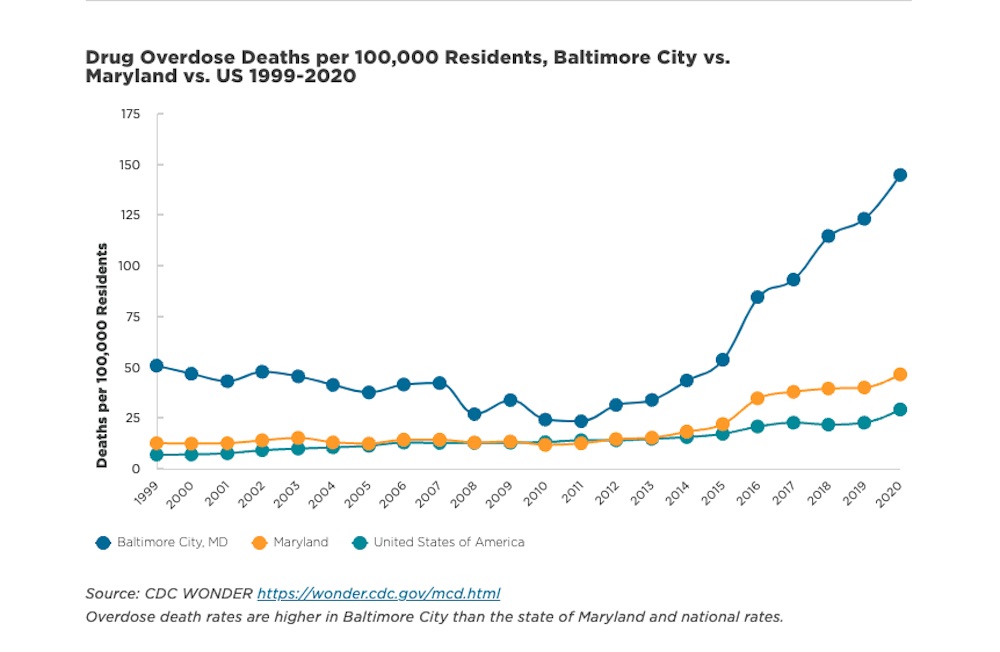It’s no secret that Baltimore is a data-driven city, and that reputation has been further supported by the recent launch of the Baltimore City Department of Health’s (BCDH) new public dashboard that tracks and reports information on opioid overdoses.
According to an announcement, the dashboard pulls data from the Maryland Department of Health Vital Statistics, Open Data Maryland, Centers for Medicare and Medicaid Services and the Centers for Disease Control. The goal of the dashboard is to ensure that Baltimore City residents are well-informed about trends in opioid overdoses and deaths. The dashboard currently contains data from 1999 through 2020.

A screenshot from Taylor Evans’ film “Zero to One Hunnid.” (Screenshot by Technical.ly)
Baltimore’s opioid epidemic is well-documented, with filmmakers like Taylor Evans highlighting its impact through such works as her 2015 film, “Zero To One Hunnid – A Baltimore Drug Documentary.” In that 2015 work, a young Black man realizes that drugs are ruling his life after the overdose of a close friend. The film’s narrative still holds today, highlighting the overdose crisis’s negative impact in Baltimore.
Mary Beth Heller, the city’s interim commissioner of health, said in a statement that the dashboard aims to not only provide publicly accessible statistics but also strengthen collaborative work among public health partners combatting this endemic issue.
“The goal of the dashboard is to ensure that Baltimore City residents are informed regarding trends in opioid overdoses and deaths,” she noted.

A dashboard graph comparing overdose death rates in Baltimore, Maryland and the US. (Screenshot by Technical.ly)
But are Baltimore’s residents already well-informed about the opioid epidemic and resulting drug overdoses in this city? Wouldn’t they be the first population impacted and in the know?
Ameejill Whitlock, a Baltimore-area emergency services provider with 27 years of experience as a medic, told Technical.ly that while she sees the dashboard as a useful tool, the timeliness of data being used raised concerns.
“Part of the issue is that the information being used for the dashboard is actually old,” Whitlock said. Those of us that are very close to the information get our information directly from either the local fire department or the opioid overdose crisis center here in the state. We’re familiar with the data that usually comes out quarterly,”
Furthermore, the new dashboard site said data for 2022 only represents suspected nonfatal overdoses responded to by EMS, as well as that numbers refer to incidents rather than unique individuals.
Whitlock also pointed out a significant issue with drugs that are resistant to naloxone, such as Xylazine, and stressed the need for real-time data.
“We need the bad batch data in real-time and we need the toxicology report so we can let community people know like, hey, you don’t want that,” Whitlock said.
Apart from providing data trends, BCDH said the dashboard also offers information on the science of addiction and access to resources, including naloxone training and treatment resources.
Join our growing Slack community
Join 5,000 tech professionals and entrepreneurs in our community Slack today!
Donate to the Journalism Fund
Your support powers our independent journalism. Unlike most business-media outlets, we don’t have a paywall. Instead, we count on your personal and organizational contributions.

National AI safety group and CHIPS for America at risk with latest Trump administration firings

How women can succeed in male-dominated trades like robotics, according to one worker who’s done it

Geomapping goes splat: The evolving future of Google Earth



